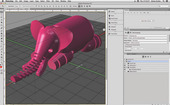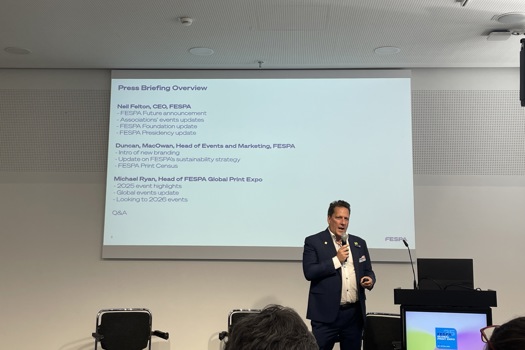What’s more, Microsoft has just added limited 3D printer support to Windows 8.1, adding yet more consumers and businesses who might potentially start dabbling with 3D print either to print at home or, more likely, at a company with high-end 3D printing kit.
Also grabbing the attention of printers is the fact 3D print will feature fairly prominently at this month’s Ipex. LGS (formerly London Graphic Systems) is taking a colour 3D printer to run output from Creative Edge’s IC3D packaging visualisation software in Ipex’ s Innovation Zones. Meanwhile, print group Hobs is taking a 3D printer to show the architectural models it handles commercially through the studio it established last year. And John Charnock, consultant and former St Ives group technical director, is hoping to have an operating 3D printer in the Inspiration Avenue he’s helping to organise.
Of course feverish excitement around 3D print developments is nothing new to printers. While in the early days manufacturers used boring names such as “additive manufacturing” and “rapid prototyping”, three or four years ago some of them started calling it 3D printing.
After the press had seized on 3D print, public interest went from roughly zero to wildly overblown expectations – with the attention of print MDs grabbed too. Then printers learned that the technology and market conditions were, in fact, still not quite right for most of them to get involved.
But these latest Adobe and Windows developments, and the fact that one of print’s largest shows is keen to educate printers on the process, could be taken as reasons to reassess.
Encouraging for any printers considering getting involved are Adobe’s reasons for adding 3D printing to its flagship creative graphics program. Photoshop product manager Andy Lauta says that essentially the company sees it as another output process, in the same way that it originally developed PostScript and then PDF for 2D printing.
“People talk about 3D printing and they talk about equipment, because it’s really cool to see a 3D printer produce something from scratch on a print bed,” he says. “But it’s really just a content business, the same as 2D printing, or video or vector graphics are digital content. It’s a natural fit for us to provide tools to help enable the creation and production of that content.
“You need printers on the back end to produce that content, and there are some significant overlaps between companies that produce 2D printing and 3D,” continues Lauta. “For big printing companies, it would be foolish not to at least consider getting into that business – and when they do, we will enable them.”
Indeed, printing companies are used to funding and operating high-cost capital equipment, they’re geared up to receiving and outputting digital files, and a lot of them have online web to print ordering, points out Charnock. “They’re also into customer service and fulfilment, and pre-flighting and checking,” he says. “OK, they’ve got to learn new skills, but that’s no different to when Macs came out and we all had to learn to operate them.”
“The more consumers get little printers, the sub-£1,000 models, the more they will start projects and then they’ll need something more,” adds Charnock. “They’ll outgrow their little ones and look for a bureau that has better equipment.”
Printers can monetise 3D products in a similar way to 2D ones, says Ken Whild, southern area sales manager of HK Technologies in Rugby, a Stratasys 3D print machine VAR which handles the higher end models and is now also establishing an output bureau.
“The average 3D print bureau part cost is about £300,” says Whild (who last month gave a talk on 3D print to an audience of printers and creatives at Stationers’ Hall in London). “I read a while ago that the average 2D print job is worth about £400. So they’re comparable in value, if not in volume.”
Many printers are realising how valuable their colour expertise could be to those ordering 3D print. “I think the key thing is that printing companies today are using a lot of colour, so they could be thinking about how that can translate into 3D markets,” says Cathy Lewis, marketing officer at US-based 3D Systems, one of the largest 3D printer manufacturers and a company with a wide range of models, from consumer up to industrial.
“For instance architects and engineers can take advantage of model printing. They would generally like either bright white or full-colour models,” she says. “That would be a good target audience for someone in the 3D printing space today, as they may already be doing some printing for those folks.”
Lewis points out that there’s a considerable 3D output bureau market already, estimating that there are 600 or 700 in North America and Europe. “However, they are generally dealing with engineers,” she says. “So they’re not necessarily tapping into the same audience that 2D printing companies could tap into.”
Another key audience printers could be tapping into with their colour prowess is marketers, adds Lewis. “Something we have seen recently is that people in marketing communications or public relations are starting to think of using 3D printing to make their point. For instance, when you walk into a presentation, how better to get that new client interested than to give them a physical model of the trade show booth that you’re going to recommend? There could be some real potential in the marketing area.”
“Printers are already dealing with a lot of marketing people and if they pick colour as one of the mainstays of 3D printing then they could offer a wider list to the main clients,” she adds.
With the launch of the Adobe capabilities, then, could come the chance for printers to use their skills for 3D print. Hopefully customers will also have the tools for the first time to start experimenting with this capability.
Jon Tolley, managing director of Prime Group, which installed an HP Designjet 3D printer a few years ago, feels that the development of more sophisticated technology will help things along.
“We’ve yet to find anything much of commercial value to do on it. It’s good for personalised gifts,” he says of the Designjet. “I know this technology is coming up rapidly, which will make it quicker.”
But some say that this could actually prove the sticking point. John Draycott is marketing manager at ArtSystems, distributor of Stratasys home and industrial-level 3D printing kit. He urges caution: “I think the technology is still too raw for any kind of mass uptake in the traditional 2D commercial print world,” he says.
“3D is getting a lot of media hype but people soon realise seeing it on CSI is not perhaps giving a true picture of its abilities. Key restrictions are print speeds, print/build size, post-print treatment and material durability. Yes, I can see some very bespoke applications that might be worth printers looking at, but nothing that would make most printers add the technology to their offering yet.
“There are 3D print bureaux, but they really serve the existing markets with little crossover into traditional print,” adds Draycott. “I know of one that does the 3D prototype work for Jaguar cars, but I also know the printer who does their showroom printing and the two never cross over.”
Phil Reeves, managing director of the additive manufacturing analyst company Enonolyst, agrees that opportunities are generally highly niche and so won’t match up well with printers’ current customer bases. “I think there will be a lot of opportunities for new products, but they will be services by specialist companies,” he says.
“There isn’t a general-purpose 3D printer in the same way as there are general purpose 2D printing presses. So the 3D bureaux tend to have picked their technology and then adapted their marketing and developed their customer channels to suit that. If they have a colour machine they’ll focus on toys and games and giveaways, if they have a mono polymer machine then they’ll look at prototyping for the automotive or aerospace industries,” adds Reeves.
Gee Ranasinha, consultant at soon-to-be Ipex exhibitor LGS, is not even convinced of the crossover of skills argument the likes of Adobe and 3D Systems make. He says printers attending LGS’s regular “lunch and learn” events, where it invites creatives in to look at what 3D can do, often have a “rude awakening”.
“They think that just because it’s got an inkjet head then it’s printing. But you need to have other software pieces in place between creating the model and optimising it for 3D printing,” says Ranasinha. “There is also a considerable amount of manual work needed to optimise these models for the way they’re built, for the resolution, and if you’re into colour management then there’s an issue there as well.”
So it seems that there may well be bigger challenges facing 2D printers wanting to add an extra dimension, than the fact customers have only just gained 3D print Adobe capabilities. Technological restrictions and difficulty cracking niche markets are just some of the challenges printers will face.
Not that printers should be totally discouraged. For all those saying 2D and 3D print are worlds apart, there are after all plenty saying the complete reverse. Has the situation changed since printers last investigated the facts behind the hype? Largely, no. But this doesn’t mean the technology isn’t still worth a closer look.
Right now, 3D printing occupies the wild frontier, the same way personal computers and desktop publishing did 30 years ago. Everyone knew they were going to be really important, if only they could work out what to do with them. Likewise, over time 3D will settle down and realism will set in as the market decides who needs it and what for.
3D printing kit manufacturers & resellers - who’s doing what?
3D Systems in California is one of the largest printer manufacturers, whose founder Chuck Hill developed the first 3D stereolithography printer in 1986. The company is growing rapidly, having acquired rival manufacturer Z Corp in 2012, followed this year by buying part of Xerox’s solid ink manufacturing facility in Oregon, which already made printheads for 3D Systems devices. Today 3D Systems makes 3D printers for several processes, ranging from £750 desktop Cube models aimed at hobbyists, through to big industrial devices costing around £650,000. Full colour models tend to range in price from about £15,000 to £75,000.
Founded in 1989, Stratasys is the main competitor to 3D Systems and has a similarly wide range of kit. Originally it concentrated on FDM (fused deposition modelling) filament type printers, and for a couple of years from 2010 HP put its own badge on Stratasys uPrinters, calling them DesignJet 3D. In 2012, Stratasys merged with Objet, a company once part-owned by Scitex. Objet printers use Xaar inkjet heads, building models out of layers of UV-cured polymer. Its PolyJet technology can mix seven materials between hard and rubbery, clear and black or white, in the same model.
In January it announced the new Objet500 Connex3, with extra heads that allow a wider colour range to be blended from cyan, magenta and yellow materials. Alternatively two or three process or special colours can be combined with black, white, clear, rubber-like and so on. Last year Stratasys also bought MakerBot, whose machines were some of the first to popularise affordable, “prosumer” printers. The company has also just appointed its first overseas distributor, Art Systems in Nottingham, which will handle the mid-range Idea models costing from £7,000 upwards.
LGS in Covent Garden supplies copiers and digital printers, with a core market in London creative services. It’s now taken on a few 3D printers, including a full-colour 3D Systems ProJet 660pro, which is kept at the iMakr demo centre a couple of miles away in Clerkenwell. This printer is being used to produce human figurines of customers in nearby Selfridges, who are 3D scanned in-store using multiple digital cameras taking simultaneous images.
 Star Trek characters Some UK stores, including Asda and Selfridges, are offering to scan you and print mini-yous. 3D Systems goes one better in the US with its Cubify website, where you can project your own face onto the body of your favourite Star Trek character. Boss-as-Borg might sell well.
Star Trek characters Some UK stores, including Asda and Selfridges, are offering to scan you and print mini-yous. 3D Systems goes one better in the US with its Cubify website, where you can project your own face onto the body of your favourite Star Trek character. Boss-as-Borg might sell well.
![]() Avatar bust This full-sized bust of the giant female alien Neytiri from Avatar was used for the movie’s Japanese premiere. It was printed in a single piece by Legacy Effects in California, using a 3D Systems iPro8000, with smaller details printed on an Objet Connex 500.
Avatar bust This full-sized bust of the giant female alien Neytiri from Avatar was used for the movie’s Japanese premiere. It was printed in a single piece by Legacy Effects in California, using a 3D Systems iPro8000, with smaller details printed on an Objet Connex 500.
 The bike helmet was printed on the new full-colour Stratasys Objet500 Connex3 as a single piece job, mixing cyan, magenta and yellow plastics from separate print heads. Different hardnesses can also be blended.
The bike helmet was printed on the new full-colour Stratasys Objet500 Connex3 as a single piece job, mixing cyan, magenta and yellow plastics from separate print heads. Different hardnesses can also be blended.
Photoshop’s new 3D printing capabilities
 3D in Photoshop is nothing new; it’s had a basic shape generator for many years. This has been improved a bit over the years, but it’s not intended for complex modelling. You can, however, import more complex models from third-party programs, using standard file formats such as OBJ, then paint on these directly or project graphics onto their surfaces like transfers.
3D in Photoshop is nothing new; it’s had a basic shape generator for many years. This has been improved a bit over the years, but it’s not intended for complex modelling. You can, however, import more complex models from third-party programs, using standard file formats such as OBJ, then paint on these directly or project graphics onto their surfaces like transfers.
What’s entirely new in the latest Creative Cloud upgrade is direct support for 3D printing. Using the new 3D print menu is ridiculously easy – the attraction is the one-click automation. You choose an output method, then select the Print button. Depending on your output method, Photoshop does the rest. It’s like a cross between a preflight fixer and a printer driver. It can automatically analyse and fix “watertightness” problems (ie unwanted holes in the 3D mesh) as well as making sure the wall thickness is appropriate for the print method. It also detects the need for support scaffolding if the shape and printer type dictates it, then generates it automatically.
Photoshop CC initially supports a small range of mostly consumer-level printers for local printing, attached directly to your computer. More drives are being added by Adobe and it provides instructions to write your own in XML. You can also save files in the standard STL format and send these to virtually any 3D printer, including high-end models.
The other output option is online ordering from Shapeways, one of the biggest online ordering bureaux, with printing agents in the UK and mainland Europe. Here the menu gives you a long choice of material types and colours (including plastics, metals, ceramics and “sandstone”), which are then simulated in the final output preview.
Andy Lauta at Adobe says that the Shapeways link isn’t exclusive – it just happens to be the first.
While Adobe is proud of its automatic mesh-fixing and scaffolding generator, it’s not unique: Autodesk for one offers it in some of its 3D systems, including the free Meshmixer.










